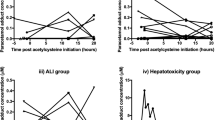Abstract
Background
Acetaminophen (APAP)-associated transaminase elevation, induced by N-acetyl-p-benzoquinone imine (NAPQI) protein adduction, remains an area of research interest. Distinct from known genetic, physiologic, and dosage associations dictating severity of hepatic injury, no known factors predict an absence of protein adduct formation at therapeutic APAP dosing.
Hypothesis
Sex-based physiology is predictive of APAP-induced protein adduct formation and differential metabolite expression at therapeutic doses.
Methods
This retrospective study interrogated serum samples collected for a prior study investigating fluctuations of alanine aminotransferase (ALT) over time with 4G daily APAP dosing for ≥ 16 days in subjects from Denver, Colorado. Subjects were grouped by adduct formation (n = 184) vs no adducts (n = 20). Samples were run on ultra-high-performance liquid chromatography mass spectrometry from study days 0, 7, 16, and 31. Significant metabolite expressions were identified using t-tests with false discovery rate correction (FDR), partial least squares discriminant, and ANOVA simultaneous comparison analyses. Demographic and clinical data were explored using t-tests with FDR (age, weight, BMI, ALT) and Chi-square (sex, ethnicity, race) analyses.
Results
In pre-treatment samples, relative quantitation caprylic acid was expressed ninefold higher and 6-carboxyhexanoate was expressed threefold lower in subjects who did not develop adducts. Lactate had greater expression in the no adducts group (p = 0.001). Using absolute quantitation, glutathione was expressed 2.6-fold greater among no adduct subjects. Odds of males developing NAPQI protein adducts at therapeutic APAP dosing were 5.91 times lower than females (95% CI = 2.3–14.9; p = 0.0001).
Conclusion
Multiple metabolites were differentially expressed based on adduct group and sex. Metabolites were identified unique to adduct development independent of sex. At therapeutic APAP dosing, males were less likely to develop APAP protein adducts. Further research into lipid biosynthesis and metabolism may provide further insight into physiology associated with adduct production.









Similar content being viewed by others
References
James LP, Alonso EM, Hynan LS, Hinson JA, Davern TJ, Lee WM, et al. Detection of acetaminophen protein adducts in children with acute liver failure of indeterminate cause. Pediatrics. 2006;118(3):e676–81.
Davern TJ 2nd, James LP, Hinson JA, Polson J, Larson AM, Fontana RJ, et al. Measurement of serum acetaminophen-protein adducts in patients with acute liver failure. Gastroenterology. 2006;130(3):687–94.
Bond GR. Acetaminophen protein adducts: a review. Clin Toxicol (Phila). 2009;47(1):2–7.
Heard KJ, Green JL, James LP, Judge BS, Zolot L, Rhyee S, et al. Acetaminophen-cysteine adducts during therapeutic dosing and following overdose. BMC Gastroenterol. 2011;11:20.
Heard K, Green JL, Anderson V, Bucher-Bartelson B, Dart RC. Paracetamol (acetaminophen) protein adduct concentrations during therapeutic dosing. Br J Clin Pharmacol. 2016;81(3):562–8.
O’Connell TM, Watkins PB. The application of metabonomics to predict drug-induced liver injury. Clin Pharmacol Ther. 2010;88(3):394–9.
Clayton TA, Lindon JC, Cloarec O, Antti H, Charuel C, Hanton G, et al. Pharmaco-metabonomic phenotyping and personalized drug treatment. Nature. 2006;440(7087):1073–7.
Winnike JH, Li Z, Wright FA, Macdonald JM, O’Connell TM, Watkins PB. Use of pharmaco-metabonomics for early prediction of acetaminophen-induced hepatotoxicity in humans. Clin Pharmacol Ther. 2010;88(1):45–51.
Heard K, Green JL, Anderson V, Bucher-Bartelson B, Dart RC. A randomized, placebo-controlled trial to determine the course of aminotransferase elevation during prolonged acetaminophen administration. BMC Pharmacol Toxicol. 2014;15:39.
U.S. Department of Health and Human Services Food and Drug Administration. Guidance for industry and investigators- safety reporting requirments for INDs and BA/BE studies. In: Adminstration UFD, editor. Silver Springs, MD2012. p. 32. Available at: https://www.fda.gov/files/drugs/published/Safety-Reporting-Requirements-for-INDs-%28Investigational-New-Drug-Applications%29-and-BA-BE-%28Bioavailability-Bioequivalence%29-Studies.pdf
Sonn BJ, Saben JL, McWilliams G, Shelton SK, Flaten HK, D’Alessandro A, et al. Predicting response to lisinopril in treating hypertension: a pilot study. Metabolomics. 2019;15(10):133.
Nemkov T, Reisz JA, Gehrke S, Hansen KC, D’Alessandro A. High-Throughput Metabolomics: Isocratic and Gradient Mass Spectrometry-Based Methods. Methods Mol Biol. 2019;1978:13–26.
Thonusin C, IglayReger HB, Soni T, Rothberg AE, Burant CF, Evans CR. Evaluation of intensity drift correction strategies using MetaboDrift, a normalization tool for multi-batch metabolomics data. J Chromatogr A. 2017;1523:265–74.
Nemkov T, D’Alessandro A, Hansen KC. Three-minute method for amino acid analysis by UHPLC and high-resolution quadrupole orbitrap mass spectrometry. Amino Acids. 2015;47(11):2345–57.
Nemkov T, Hansen KC, D’Alessandro A. A three-minute method for high-throughput quantitative metabolomics and quantitative tracing experiments of central carbon and nitrogen pathways. Rapid Commun Mass Spectrom. 2017;31(8):663–73.
Chong J, Soufan O, Li C, Caraus I, Li S, Bourque G, et al. MetaboAnalyst 4.0: towards more transparent and integrative metabolomics analysis. Nucleic Acids Res. 2018;46(W1):W486–94.
Maes M, Leonard BE, Myint AM, Kubera M, Verkerk R. The new “5-HT” hypothesis of depression: cell-mediated immune activation induces indoleamine 2,3-dioxygenase, which leads to lower plasma tryptophan and an increased synthesis of detrimental tryptophan catabolites (TRYCATs), both of which contribute to the onset of depression. Prog Neuropsychopharmacol Biol Psychiatry. 2011;35(3):702–21.
Nilsson LK, Nordin C, Jönsson EG, Engberg G, Linderholm KR, Erhardt S. Cerebrospinal fluid kynurenic acid in male and female controls - correlation with monoamine metabolites and influences of confounding factors. J Psychiatr Res. 2007;41(1–2):144–51.
Sonn BJ, Heard KJ, Heard SM, D'Alessandro A, Reynolds KM, Dart RC, et al. Metabolomic markers predictive of hepatic adaptation to therapeutic dosing of acetaminophen. Clin Toxicol (Phila). 2021;60(2):221–230.
Bennett MJ, Ragni MC, Hood I, Hale DE. Azelaic and pimelic acids: metabolic intermediates or artefacts? J Inherit Metab Dis. 1992;15(2):220–3.
Ingebretsen OC. Mechanism of the inhibitory effect of glyoxylate plus oxaloacetate and oxalomalate on the NADP-specific isocitrate dehydrogenase. Biochim Biophys Acta. 1976;452(2):302–9.
Ruffo A, Testa E, Adinolfi A, Pelizza G, Moratti R. Control of the citric acid cycle by glyoxylate. Mechanism of the inhibition by oxalomalate and gamma-hydroxy-alpha-oxoglutarate. Biochem J. 1967;103(1):19–23.
Saitoh W, Yamauchi S, Watanabe K, Takasaki W, Mori K. Metabolomic analysis of arginine metabolism in acute hepatic injury in rats. J Toxicol Sci. 2014;39(1):41–50.
Scholz R, Schwabe U, Soboll S. Influence of fatty acids on energy metabolism. 1. Stimulation of oxygen consumption, ketogenesis and CO2 production following addition of octanoate and oleate in perfused rat liver. Eur J Biochem. 1984;141(1):223–30.
Fan S, Yeon A, Shahid M, Anger JT, Eilber KS, Fiehn O, et al. Sex-associated differences in baseline urinary metabolites of healthy adults. Sci Rep. 2018;8(1):11883.
Rubin JB, Hameed B, Gottfried M, Lee WM, Sarkar M. Acetaminophen-induced Acute Liver Failure Is More Common and More Severe in Women. Clin Gastroenterol Hepatol. 2018;16(6):936–46.
Funding
The parent study was funded by Johnson and Johnson. A.A.M. received support from NIH R35GM124939 and NIH CTSI UL1 TR001082 for this work.
Author information
Authors and Affiliations
Corresponding author
Ethics declarations
Conflict of Interest
None. However, the original project that collected the samples used for this study was supported by an investigator-initiated grant from McNeil Consumer Healthcare. Authors received only salary for their work on the project.
Additional information
Supervising Editor: Anselm Wong, MBBS DipTox PhD
Publisher's Note
Springer Nature remains neutral with regard to jurisdictional claims in published maps and institutional affiliations.
Prior Presentations: Data in this manuscript were previously presented as a platform at ACMT’s Annual Scientific Meeting, Virtual, 2021.
Supplementary Information
Below is the link to the electronic supplementary material.
Rights and permissions
About this article
Cite this article
Arnold, C.G., Dylla, L., Monte, A. et al. Metabolomic Evaluation of N-Acetyl-p-Benzoquinone Imine Protein Adduct Formation with Therapeutic Acetaminophen Administration: Sex-based Physiologic Differences. J. Med. Toxicol. 18, 297–310 (2022). https://doi.org/10.1007/s13181-022-00903-5
Received:
Revised:
Accepted:
Published:
Issue Date:
DOI: https://doi.org/10.1007/s13181-022-00903-5




